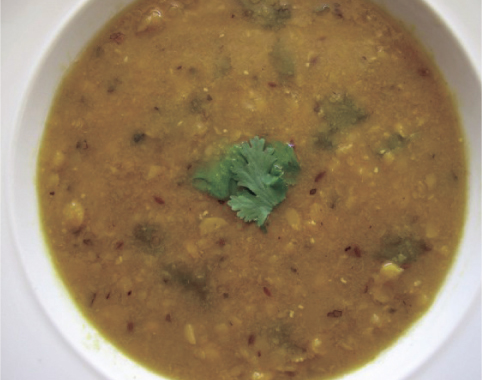Mama’s Punjabi Recipes – Sabat Moong Di Dal (Whole Moong Lentils)
Dals are the mainstay of Indian diet, whether you are in the north or south, east or west – providing much needed protein – and each region has its own way of making them. But nowhere will you find the heartiness and flavorful taste of dals as you would in the Punjab.
Punjabi dals are known for their smooth, thick texture and the perfect blend of spices. They are not supposed to be runny or thin and the hot tardka or blending in of spices, onions, garlic and sometimes hing (asafoetida) is a sizzling experience that fills the air with the aroma of the dish.
Many people in India make dals in pressure cookers and they have brought along this method to their new homes in America too. But, in our ancestral homes in Jhung and Lyallpur in West Punjab there were no pressure cookers and we used to make dal in a large patila (pot) simmered for an hour or more over a slow to medium flame. Very often, the dal made in a cooker gets overcooked and comes out like soup! Dal should be cooked so that you can spot the grain and scoop it up with a little turri (curry).
As most people know, there are at least six major types of dals, and then some are available skinless too as this alters their taste. Skinless dals cook faster than those with the skin on. The fiber content of the skin gives dals a nuttier, earthier taste.
Some people only know dals by their color; the moong dal is leaf green when whole and comes out yellow when it is skinless. Moong dal cooks fairly fast and goes well with rice and rotis.
Ingredients:
1 cup sabat moong dal (whole moong lentils)
2 cups pani (water)
2 tbspn olive oil
4 cloves of lasan (garlic) – peeled and chopped, or use powdered garlic
1 medium adrak (ginger) – peeled and chopped, or use powdered ginger
1 tspn garam masala
5 stalktops fresh dhania (coriander) – pinch off the leaves and cut into pieces
Spices: lal mirch (red pepper); namak (salt); haldi (turmeric) – to your taste
Directions:
1. Place the moong dal in a bowl and wash it thoroughly in cold water, then rinse it out.
2. Bring the 2 cups of water to a boil over high heat. Pour in the moong dal into the pot, cover, and add the haldi, ginger and salt and let it come to a second boil then reduce the heat to medium.
3. If the water boils off before the dal becomes tender, then add some more and let it continue to boil for about 30 minutes till the dal is tender but not soft. Keep a frequent eye on the dal to make sure it does not become soupy.
4. Heat the oil in a small karai or wok and add the garlic and brown it a little. When roasted and the smell of the pieces starts to come through, take off the heat and drop the masala into the pot of cooked dal and stir to mix well.
5. Sprinkle the top of the dal with garam masala and the cut coriander leaves above.
Shakuntla Malhotra is a skilled cook of Punjabi dishes made in the old-fashioned style that she learnt as a young woman in her ancestral home in Lyallpur, India before it became part of Pakistan after the Partition in 1947. People have often admired her cooking for its simplicity and taste that comes with each mouthful. Even in her mid-eighties, she continues to cook daily and agreed to share some of her delectable Punjabi recipes.
MAMA’S TIP OF THE WEEK
COAT ONLY ONE SIDE OF ROTI TO SAVE GREASY HANDS AND EXCESS OIL
There are still quite a few South Asian households in the US where fresh rotis are made every day, even though many frozen varieties are available. But whether frozen or fresh, many people follow the old tradition to choppard (coat) one side – the fluffed up side with the thin skin – with butter or oil. This gives the roti or parantha a crispier, cooked taste.
To save oil or butter as well as not to make your hands greasy while making the rotis, it is best to choppard only one roti, then when the next one is ready, rub the two thin skin sides together and leave them stacked that way, facing each other. The newer rotis will be stacked on top, one ungreased side resting on top of the other ungreased side.


